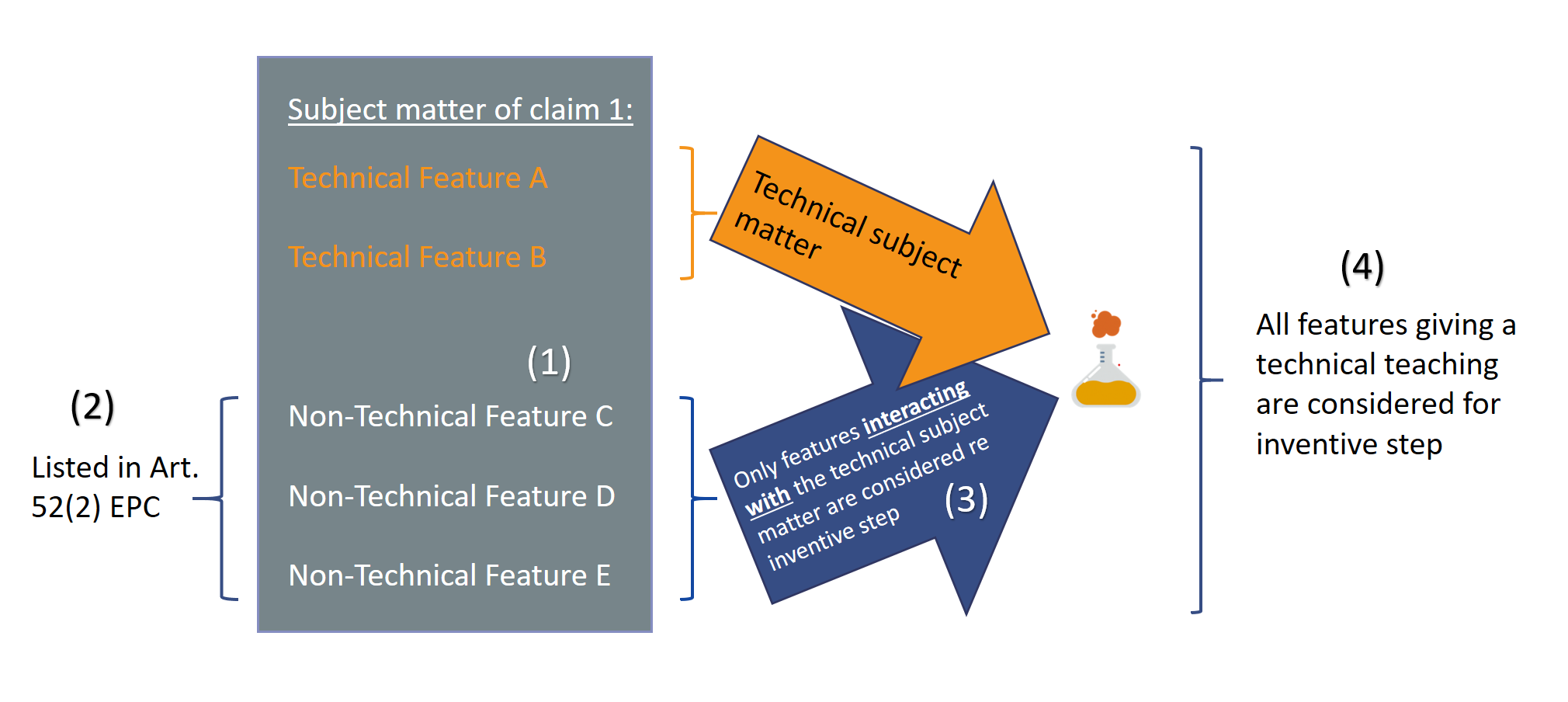A computer implemented invention claim usually has at least one technical feature (to be considered an “invention” under Article 52(1) EPC) and non-technical features from the list of non-inventions under Article 52(2) EPC, e.g. features relating to “programs for computers”. This means that there is usually a mixture of technical and non-technical features in a computer implemented invention claim. The COMVIK approach – discussed in the following chapter – is now used to determine which features in such a computer implemented invention claim can contribute to inventive step. This chapter is based on the Enlarged Board of Appeal decision G1/19, points 30 to 34.
Summarized jurisprudence of the boards of appeal regarding subject-matter excluded from patentability
Decision T 154/04 summarised the jurisprudence of the boards of appeal on the application of Articles 52, 54 and 56 EPC in the context of subject-matter and activities excluded from patentability under Article 52(2) EPC in the following principles (T 154/04, Reasons, point 5):
(A) Article 52(1) EPC sets out four requirements to be fulfilled by a patentable invention: there must be an invention, and if there is an invention, it must satisfy the requirements of novelty, inventive step, and industrial applicability.
(B) Having technical character is an implicit requisite of an “invention” within the meaning of Article 52(1) EPC (requirement of “technicality”).
( C) Article 52(2) EPC does not exclude from patentability any subject matter or activity having technical character, even if it is related to the items listed in this provision since these items are only excluded “as such” (Article 52(3) EPC).
(D) The four requirements – invention, novelty, inventive step, and susceptibility of industrial application – are essentially separate and independent criteria of patentability, which may give rise to concurrent objections. Novelty, in particular, is not a requisite of an invention within the meaning of Article 52(1) EPC, but a separate requirement of patentability.
(E) For examining patentability of an invention in respect of a claim, the claim must be construed to determine the technical features of the invention, i.e. the features which contribute to the technical character of the invention.
(F) It is legitimate to have a mix of technical and “non-technical” features appearing in a claim, in which the non-technical features may even form a dominating part of the claimed subject matter. Novelty and inventive step, however, can be based only on technical features, which thus have to be clearly defined in the claim. Non-technical features, to the extent that they do not interact with the technical subject matter of the claim for solving a technical problem, i.e. non-technical features “as such”, do not provide a technical contribution to the prior art and are thus ignored in assessing novelty and inventive step.
(G) For the purpose of the problem-and-solution approach, the problem must be a technical problem which the skilled person in the particular technical field might be asked to solve at the relevant priority date. The technical problem may be formulated using an aim to be achieved in a non-technical field, and which is thus not part of the technical contribution provided by the invention to the prior art. This may be done in particular to define a constraint that has to be met (even if the aim stems from an a posteriori knowledge of the invention).
Different types of features
According to principle (F) above it is distinguished between:
-
Technical features.
-
Non-technical features: Features which, on their own, would be considered “non-inventions” under Article 52(2) EPC (whether such features contribute to the technical character of the invention has to be assessed in the context of the invention as a whole). This definition is from G1/19.
-
Non-technical features “as such”: (In addition to the definition re non-technical features mentioned before) they do not interact with the technical subject matter of the claim for solving a technical problem. And/or, they do not provide a technical contribution to the prior art, see T 154/04 above.
Principles (F) and (G) above were established in the COMVIK-decision
The Headnote of the COMVIK-decision (T 641/00) reads as follows:
- An invention consisting of a mixture of technical and non-technical features and having technical character as a whole is to be assessed with respect to the requirement of inventive step by taking account of all those features which contribute to said technical character whereas features making no such contribution cannot support the presence of inventive step.
- Although the technical problem to be solved should not be formulated to contain pointers to the solution or partially anticipate it, merely because some feature appears in the claim does not automatically exclude it from appearing in the formulation of the problem. In particular where the claim refers to an aim to be achieved in a non-technical field, this aim may legitimately appear in the formulation of the problem as part of the framework of the technical problem that is to be solved, in particular as a constraint that has to be met.
In other words, according to principle 1 all features of the claim (both technical and non-technical features) which contribute to the technical character of the invention are considered for inventive step.
Further explanations to principle 2 are given in the discussion of the decision T 154/04.
The principles set out in the principles 1 and 2 above for dealing with non-technical features in the assessment of inventive step for computer-implemented inventions will be referred to in the following as the “COMVIK approach”.
What is the technical character?
Above, the term technical character has appeared in T 154/04 and in the Basic Proposal for the Revision of the EPC. In summary, the following definitions are used for the term technical character in G1/19:
- an implicit requisite of an “invention” within the meaning of Article 52(1) EPC,
- a requirement of “technicality”,
- a “technical teaching”, i.e. an instruction addressed to a skilled person as to how to solve a particular technical problem using particular technical means.
More about features
Features which can be considered to be technical per se do not necessarily contribute to the technical solution of a technical problem. An invention may have
(i) technical features which contribute,
(ii) technical features which do not contribute,
(iii) non-technical features which contribute and
(iv) non-technical features which do not contribute (non-technical features “as such”)
to the technical solution of a technical problem and thereby potentially to the presence or not of an inventive step.
While (i) and (iv) are self-evident, features according to (iii) have been established by the case law described above (principle (F): non-technical features interacting with the technical subject matter of the claim for solving a technical problem).
Case (ii) occurs if features that per se qualify as technical cannot contribute to inventive activity because they have no technical function within the context of the claimed invention, see e.g. T 619/02 (OJ EPO 2007, 63, Reasons, points 2.2, 2.6.2) concerning perfumes.
Example: The T619/02 is in regard to a claimed odour selection method in which the resulting odour has not been properly processed or transformed, but merely selected from among a series of existent odours. These features are not excluded by Art. 52(2) and (3) EPC. Nevertheless, the claimed method relies on no more than the perceptional assessment of odours and stimuli for the purpose of evaluating their aesthetic evocation attributes. Since beyond a purely perceptual evocative inducing effect no technical information, i.e. no technical quality or technical significance can be attributed to the selected odour, the result of the claimed method constitutes a non-technical selection. Accordingly, no technical effect is achieved by the claimed method.
In other words, in the mentioned example, the claim features seem at first glance to be excluded according to the non-invention list of Art. 52(2) EPC. However, in the view of the Board, none of the claimed features in the mentioned example is mentioned in this list. Therefore, the features are considered to be technical features. Nevertheless, the technical features have no technical effect and therefore are technical features according to (ii) above which are not considered regarding inventive step.
Even before the COMVIK approach was established, technically non-functional modifications (even if they could per se be considered technical) could be considered irrelevant in the assessment of inventive step (see T 72/95, Reasons, point 5.4).
Why was the COMVIK approach developed?
The COMVIK approach was developed as a means of applying the problem-solution approach to computer-implemented inventions that encompass non-technical features (see principle (F) mentioned above). Subsequent cases noted that the COMVIK approach does not contradict the problem-solution approach; rather, it is a special application of the problem-solution approach to inventions that contain a mix of technical and non-technical features (T 1503/12, Reasons, point 3.3).
Conclusion
The summary of this chapter regarding the COMVIK approach is illustrated in the below figure:

- The blue block (1) in the figure shows a CII claim having technical features and non-technical features. Technical features are e.g. the feature “computer implemented” (please see chapter (2) “any hardware approach”) and/or “functional data” (please see chapter (9) “Potential technical effects”) and/or other technical features.
- Non-technical features are disclosed in the list of Art. 52(2) EPC, marked with (2), e.g. features regarding “programs for computers”.
- According to the COMVIK approach, non-technical features can contribute to the technical character. For this, they have to interact with the technical subject matter of the claim (a technical subject-matter may consist, at least in part, of non-claimed technical features, please see Chapters 8 and 9). This is represented by the two arrows (3) which meet in the conical flask (in which a chemical reaction takes place).
- These non-technical features and the technical features then give technical teaching considered for inventive step, see mark (4) in the figure.
- If the non-technical features do not interact with the technical subject matter, then they are considered to be “non-technical features as such” and they are not taken into account in the inventive step.
